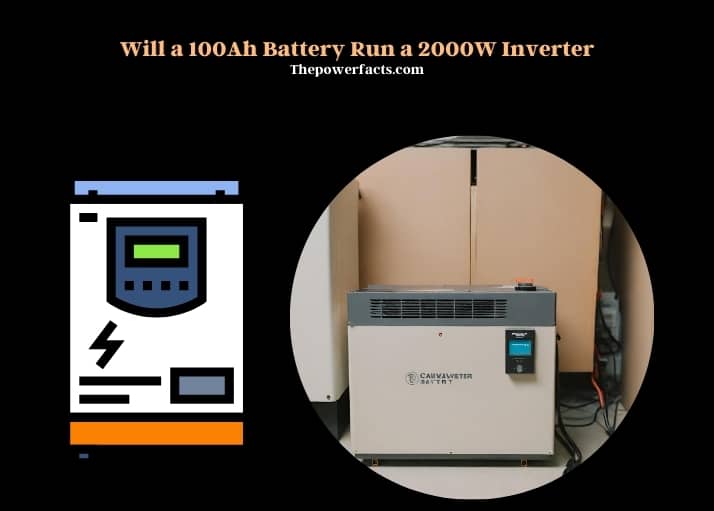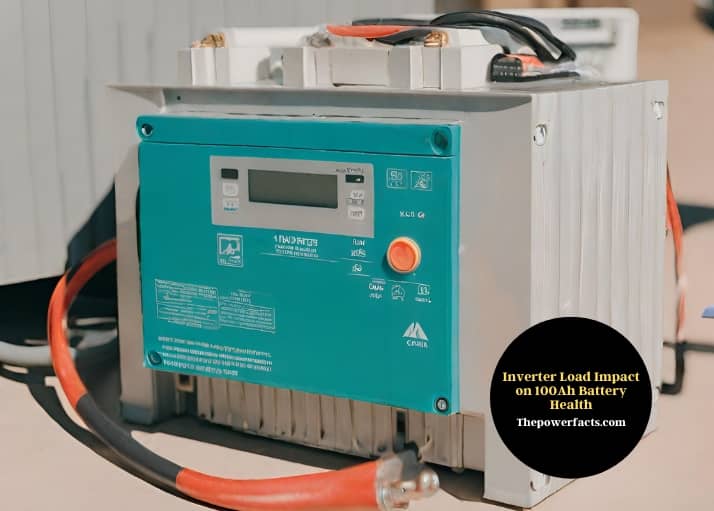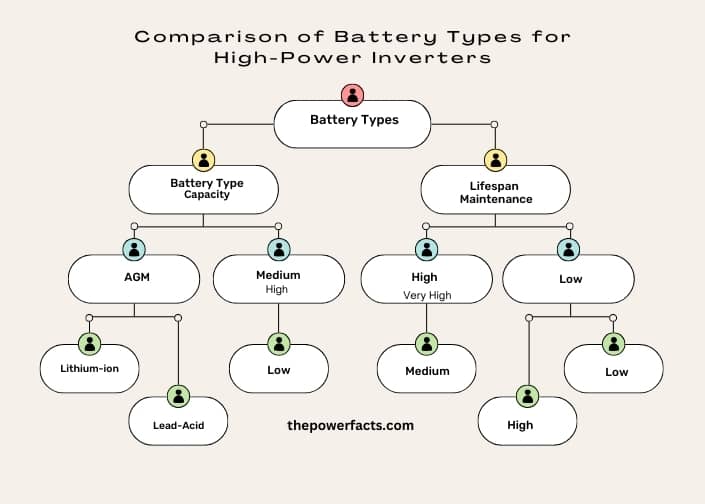A 100Ah battery can run a 2000W inverter, but its efficiency and duration are limited. The actual performance depends on various factors including the battery’s voltage, the inverter’s efficiency, and the nature of the load.
When considering the use of a 100Ah battery with a 2000W inverter, it’s essential to understand the relationship between the battery’s capacity and the power demands of the inverter. Typically, a 100Ah battery provides 12 volts, translating to 1200 watt-hours (Wh) of energy. This means that at full capacity, such a battery can theoretically run a 2000W inverter for approximately 0.6 hours.
This is an ideal scenario, assuming 100% efficiency and a fully charged battery.

In real-world applications, several factors reduce this runtime. The efficiency of the inverter, usually ranging between 85% to 95%, plays a significant role.
The nature of the load connected to the inverter impacts the battery’s discharge rate. Continuous high-power loads will drain the battery faster than intermittent or lower power loads. It’s also important to consider the depth of discharge (DoD) for the battery. Deeply discharging a battery regularly can significantly shorten its lifespan. Therefore, while a 100Ah battery can power a 2000W inverter, the duration and efficiency of this setup are constrained by these practical considerations.
Compatibility Check: 100Ah Batteries and 2000W Inverters
The compatibility of 100Ah batteries with 2000W inverters is crucial for efficient and safe operation. The key lies in assessing the battery’s capacity to handle the inverter’s power demands. A 2000W inverter, under full load, requires a substantial amount of current.
Given that most 100Ah batteries are 12V, the current draw at full load would be around 166.67 amps (2000W/12V). This is beyond the safe operating limits of most 100Ah batteries, especially considering that continuous operation at such high currents can lead to overheating and reduced battery life.
Voltage considerations are also vital. Inverters typically operate efficiently within a specific voltage range. If a battery cannot maintain this range under load, the inverter may not function optimally, leading to inefficient power conversion.
The distinction between continuous and peak power demands is essential. While a 100Ah battery might briefly support a 2000W load (peak power), it is unlikely to sustain this for an extended period (continuous power).
Runtime Calculations for 100Ah Batteries with 2000W Inverters
The runtime of a 100Ah battery powering a 2000W inverter is a critical factor for users to consider. To calculate this, one must consider the battery’s total capacity, the power demand of the inverter, and the efficiency of the system. Theoretically, a 100Ah battery at 12V can deliver 1200Wh of energy (100Ah x 12V). For a 2000W inverter, the maximum runtime can be calculated as follows: Runtime (hours) = Battery Capacity (Wh) / Power Demand (W).
This is an oversimplified calculation that does not account for inverter efficiency, which typically ranges from 85% to 95%.
Real-world performance also differs due to factors like battery age, temperature, and the nature of the load connected to the inverter. It’s important to note that running a battery at maximum capacity continuously can significantly reduce its lifespan.
Estimated Runtime of 100Ah Batteries at Different Power Loads
| Power Load (W) | Estimated Runtime (Hours) |
| 500 | 2.28 – 2.40 |
| 1000 | 1.14 – 1.20 |
| 1500 | 0.76 – 0.80 |
| 2000 | 0.57 – 0.60 |
Inverter Load Impact on 100Ah Battery Health
High power loads from a 2000W inverter can significantly impact the health and longevity of a 100Ah battery. Continuous operation at high loads leads to rapid depletion of the battery’s charge, causing heat buildup and accelerated wear. This can manifest as reduced capacity, swollen battery cases, or in severe cases, failure of the battery.

To maintain battery health, it’s advisable to operate below the maximum load capacity and ensure proper ventilation to dissipate heat. Regular maintenance checks, including monitoring charge levels and inspecting for physical damage, are essential. Users should also consider the depth of discharge (DoD) and avoid completely draining the battery, as this can significantly reduce its lifespan.
Alternative Power Solutions for 2000W Inverters
When powering 2000W inverters, exploring alternative power solutions can enhance efficiency and battery life. Different battery types, such as lithium-ion or AGM (Absorbent Glass Mat), offer varying benefits in terms of lifespan, capacity, and maintenance requirements. Hybrid power systems that combine batteries with solar panels can provide a more sustainable and long-lasting power solution, reducing the load on individual batteries.
Using multiple batteries in parallel is another viable option. This approach increases the total capacity and distributes the load, thereby reducing the strain on individual batteries and enhancing overall system longevity.
Comparison of Battery Types for High-Power Inverters
| Battery Type | Capacity | Lifespan | Maintenance |
| AGM | Medium | High | Low |
| Lithium-ion | High | Very High | Low |
| Lead-Acid | Low | Medium | High |

Selecting the Right Inverter for 100Ah Batteries
Choosing the appropriate inverter for a 100Ah battery involves considering several factors. The inverter’s efficiency rating is paramount; a higher rating means more effective conversion of battery power into usable AC power with less waste. Compatibility between the battery and inverter is also critical. This includes ensuring that the inverter’s voltage requirements align with the battery’s output.
Users should also consider the inverter’s power output relative to their needs. For a 100Ah battery, a 2000W inverter may be too demanding for continuous use. Opting for an inverter with a lower power rating or using multiple batteries can provide a more balanced and sustainable setup.
FAQs
Can a 100Ah Battery Support High-Power Appliances?
A 100Ah battery can support high-power appliances, but its capability is limited by the battery’s total watt-hour capacity and the power demand of the appliance. For instance, a 100Ah battery at 12V offers 1200 watt-hours (Wh). If an appliance, like a microwave, requires 2000 watts, the battery could technically power it, but only for a short duration.
The key is to understand the appliance’s power requirements and compare them with the battery’s capacity. It’s also crucial to consider the inverter’s efficiency, as it plays a significant role in the overall power output.
What Are the Risks of Overloading a 100Ah Battery?
Overloading a 100Ah battery by connecting it to a 2000W inverter can pose several risks. The most immediate risk is the potential for overheating, which can lead to battery damage or failure. Overloading can also cause a rapid depletion of the battery’s charge, reducing its overall lifespan.
In extreme cases, it can lead to dangerous situations like battery swelling or even explosions. Therefore, it’s essential to ensure that the battery’s capacity aligns with the inverter’s power requirements to avoid these risks.
Is It Feasible to Use Multiple 100Ah Batteries for Higher Power Needs?
Using multiple 100Ah batteries in parallel is a feasible solution for higher power needs. This setup increases the total capacity and allows for a more significant power draw without overloading individual batteries.
For example, two 100Ah batteries connected in parallel effectively double the capacity to 200Ah, providing more headroom for a 2000W inverter. This approach not only enhances the power output but also contributes to the longevity of the batteries by distributing the load.
How Does Temperature Affect a 100Ah Battery Running a 2000W Inverter?
Temperature plays a critical role in the performance of a 100Ah battery running a 2000W inverter. Extreme temperatures, both hot and cold, can significantly impact the battery’s efficiency and lifespan. High temperatures can increase the rate of chemical reactions inside the battery, leading to faster depletion and potential overheating.
Conversely, cold temperatures can reduce the battery’s capacity and its ability to deliver high currents. It’s important to operate the battery within its recommended temperature range to ensure optimal performance and longevity.
What Precautions Should Be Taken While Using a 100Ah Battery with a 2000W Inverter?
When using a 100Ah battery with a 2000W inverter, several precautions are necessary. Firstly, ensure that the battery is capable of handling the inverter’s maximum power draw. It’s also crucial to monitor the battery’s charge level and avoid deep discharges. Regular maintenance, including checking connections and ensuring the battery is not exposed to extreme temperatures, is vital.
Using a battery management system (BMS) can help in monitoring the battery’s health and preventing overcharging or excessive discharge.
How Long Can a 100Ah Battery Power a 2000W Inverter?
The duration for which a 100Ah battery can power a 2000W inverter depends on several factors, including the battery’s state of charge, age, and the actual power draw of the connected devices. Under ideal conditions, a fully charged 100Ah battery at 12V (providing 1200Wh of energy) could theoretically run a 2000W load for about 0.6 hours.
This is a best-case scenario, and real-world factors like inverter efficiency and intermittent loads can affect the actual runtime. It’s also important to note that consistently running the battery at such high loads can lead to quicker degradation.
Summary
In summary, while a 100Ah battery can technically power a 2000W inverter, practical considerations such as battery health, efficiency, and runtime significantly limit this capability. Understanding these factors, along with exploring alternative power solutions and selecting the right inverter, can help users create a more efficient and sustainable power system.